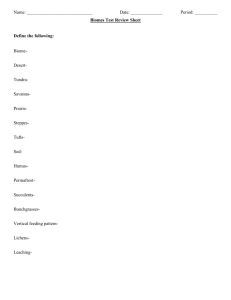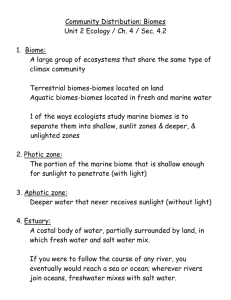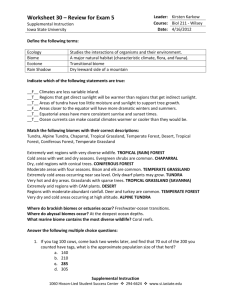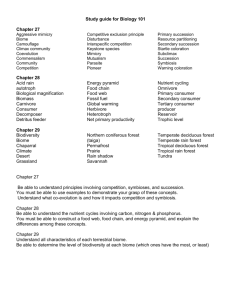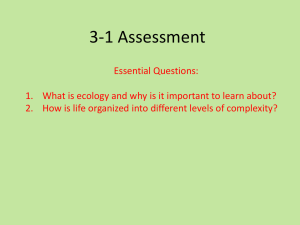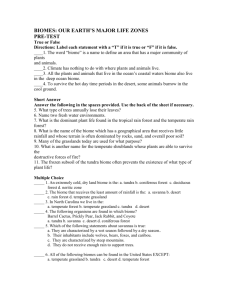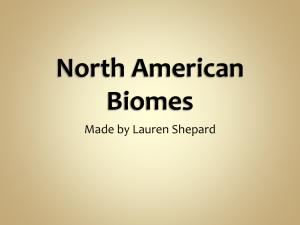Biomes Which of the following is a biotic factor in a biome? Kinds of
advertisement
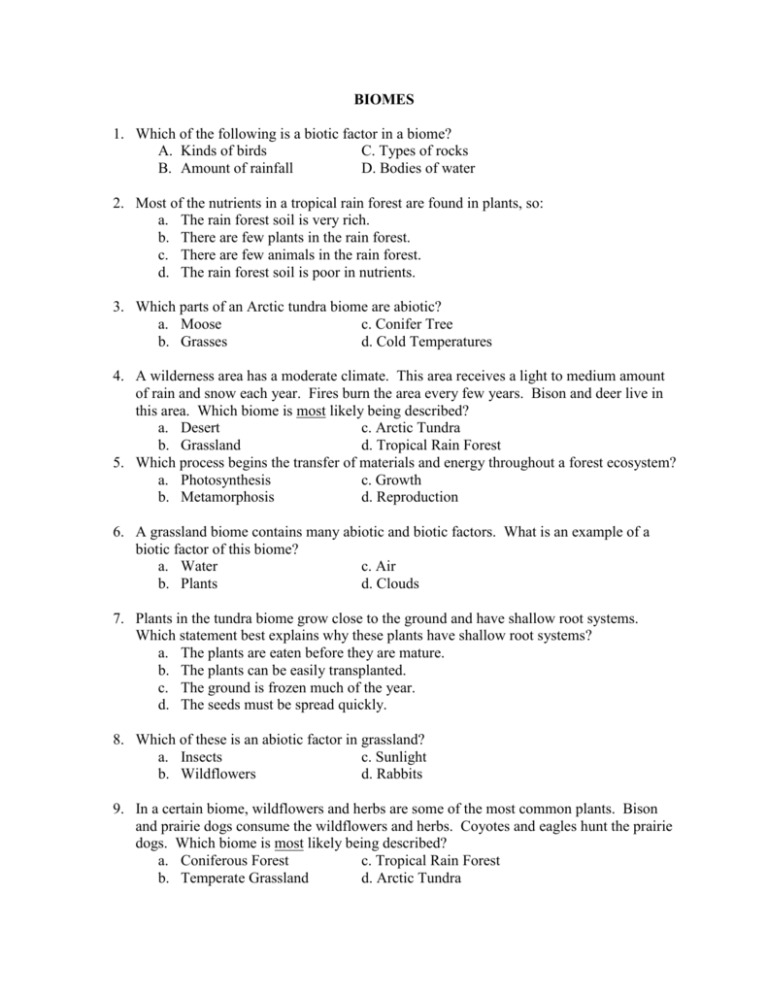
BIOMES 1. Which of the following is a biotic factor in a biome? A. Kinds of birds C. Types of rocks B. Amount of rainfall D. Bodies of water 2. Most of the nutrients in a tropical rain forest are found in plants, so: a. The rain forest soil is very rich. b. There are few plants in the rain forest. c. There are few animals in the rain forest. d. The rain forest soil is poor in nutrients. 3. Which parts of an Arctic tundra biome are abiotic? a. Moose c. Conifer Tree b. Grasses d. Cold Temperatures 4. A wilderness area has a moderate climate. This area receives a light to medium amount of rain and snow each year. Fires burn the area every few years. Bison and deer live in this area. Which biome is most likely being described? a. Desert c. Arctic Tundra b. Grassland d. Tropical Rain Forest 5. Which process begins the transfer of materials and energy throughout a forest ecosystem? a. Photosynthesis c. Growth b. Metamorphosis d. Reproduction 6. A grassland biome contains many abiotic and biotic factors. What is an example of a biotic factor of this biome? a. Water c. Air b. Plants d. Clouds 7. Plants in the tundra biome grow close to the ground and have shallow root systems. Which statement best explains why these plants have shallow root systems? a. The plants are eaten before they are mature. b. The plants can be easily transplanted. c. The ground is frozen much of the year. d. The seeds must be spread quickly. 8. Which of these is an abiotic factor in grassland? a. Insects c. Sunlight b. Wildflowers d. Rabbits 9. In a certain biome, wildflowers and herbs are some of the most common plants. Bison and prairie dogs consume the wildflowers and herbs. Coyotes and eagles hunt the prairie dogs. Which biome is most likely being described? a. Coniferous Forest c. Tropical Rain Forest b. Temperate Grassland d. Arctic Tundra 10. Which of these are biotic factors found in freshwater biomes? a. Minerals c. Oxygen Levels b. Sediments d. Pond Snails 11. The fur of Arctic foxes and Arctic hares is white in winter. The fur of both species becomes brown in summer. This adaptation helps camouflage these animals. In which biome can a predator-prey relationship between Arctic foxes and Arctic hares be found? a. Desert c. Wetland b. Rain Forest d. Tundra 12. Which of these is an abiotic factor in a tropical rain forest? a. Kapok Tree c. Bucket Orchid Flower b. High Humidity d. Blue Mountain Butterfly 13. Which two biomes have very limited precipitation? a. Coniferous Forest and Grassland c. Temperate Forest and Grassland b. Desert and Taiga d. Tundra and Desert 14. Which are the two MOST important factors that determine the climate in any biome of the world? a. Temperature and precipitation c. mountain ranges and temperature b. Prevailing wind and precipitation d. prevailing wind and mountain ranges 15. Mary Ann’s class was planning a weeklong camping trip. Her teacher said the area is high in the Rocky Mountains, where snow is common. Conifers such as spruce and hemlock are abundant around the camp. Animals they might see include elk, bighorn sheep, moose, and grizzle bears. In which biome is this camp located? a. Tundra c. Grassland b. Taiga d. Desert 16. Three students use their bodies to show how the sun, the moon, and Earth area aligned during the phases of the moon. What is one limitation of this model? a. It cannot show the relative motion of the three objects. b. It cannot be safely used to show gaseous objects such as the sun. c. It cannot show how the sun’s light affects the moon’s appearance. d. It cannot be used to show the direction of Earth’s revolution. The venus flytrap is a carnivorous plant that lives in swampy habitats where there is little nitrogen. As a result, the flytrap has evolved to receive nitrogen and other nutrients from insects. The plant has two leaves that resemble jaws, and when the insects land on the plant, the leaves close on the insect. The plant then digests it. A researcher grows three venus flytraps in a greenhouse containing swampy soil. Plants 1 and 2 are given equal amounts of fertilizers X and Y. Plant 3 is not given any fertilizer. Fertilizers X and Y differ in the amount of nitrogen they contain. 17. What is the control group for this experiment? a. Plant 1 c. Plant 3 b. Plant 2 d. Plants 1 and 2 18. What is the dependent variable? a. Fertilizer b. Venus flytrap c. Amount of Nitrogen d. Plant Growth 19. What is the independent variable? a. Fertilizer b. Venus flytrap c. Amount of Nitrogen d. Plant Growth The two graduated cylinders pictured can hold the same amount of water and use the same scale. A student measures the masses of metal balls. One ball is made of aluminum and the other ball is made of lead. The student adds 50 mL of water to each graduated cylinder and then drops one metal ball into each graduated cylinder. 20. Which tool did the student use to measure the mass of each metal ball? a. Ruler c. Balance b. Timer d. Graduated Cylinder MATCHING _____ 21. has permafrost; in the Arctic or Antarctic _____ 22. has many trees that do not change much seasonally _____ 23. has organisms with special adaptations to a hot, dry climate _____ 24. has clumps of trees and seasonal rains _____ 25. has many trees that lose all of their leaves to save water _____ 26. has grass, but few trees due to fires, drought, and grazing Bioengineering 27. What is assistive bioengineering? 28. Give one example of assistive bioengineering. 29. What is adaptive bioengineering? 30. Give one example of adaptive bioengineering. Science Tools 31. What tool is used to measure time? 32. What tool is used to measure length? 33. What tool is used to measure temperature? 34. What tool is used to see tiny objects? 35. What tool can make objects that are a few yards away appear larger? Variables 36. Define a dependent variable 37. Define an independent variable. 38. Define a constant. 39. Define the control group. 40. Define a controlled experiment. a. temperate deciduous forest b. coniferous forest c. temperate grassland d. savanna e. desert f. tundra

